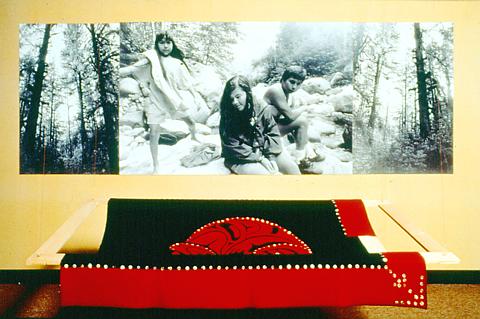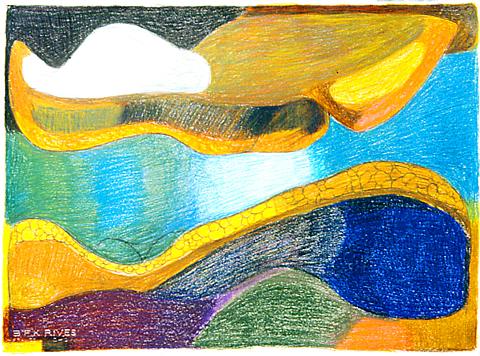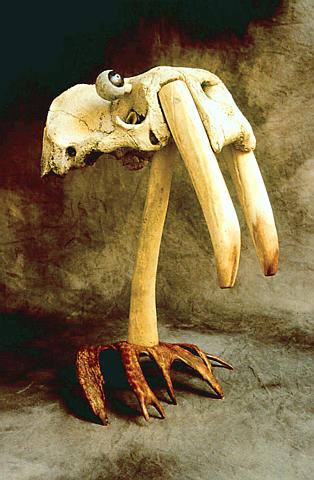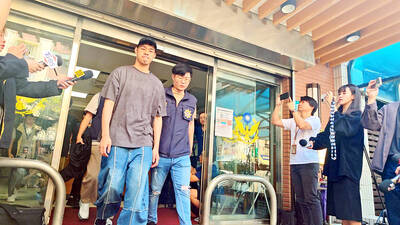It was commonly believed in the West -- and may still be believed -- that the art of the native peoples of North America was primitive and exotic, distinctly inferior to Euro-American art.
"Transitions," an exhibition of paintings, sculptures and mixed-media works created by Indian and Eskimo artists, attempts to dispel those preconceptions.
This traveling exhibition of contemporary Canadian Indian and Inuit art that showcased at the Taipei Fine Arts Museum this past spring was shown alongside works by artists from the indigenous tribes of Taiwan. However, the smaller Tainan space where it is currently showing can only accommodate the 24 works by the Canadian artists.

Many of them use traditional materials, such as fossilized whalebone, caribou antler, seal skin and embroidery, and combine it with modern materials, such as acrylic paint, sepia toner, photographs and computer circuit boards. The exhibition rejects the myth that indigenous art is a fossilized artifact and instead shows that the various indigenous cultures in North America are alive and flourishing.
Mainly dealing with issues of identity and exploring what it means to be an Indian, the artists mix Indian images and techniques with Western art materials and styles. The result is contemporary art unique to their culture despite the Western influences.
For Transitions, the work of the 13 Inuit artists doesn't seem as overtly political as their Indian counterparts, but since they are using power tools instead of hand tools and are not creating the typical touristy images of polar bears, their work is subtle yet subversive. The majority of the Inuit artists has carved sculptures out of stone or bone to depict their sense of spirituality or their connection with the land.

Walrus Composition (1996) by Jobie Arnaituk is a sculpture made of walrus skull, caribou antler and soapstone that conveys the fierce power and spirit of a bull walrus, an animal vital to his shamanic culture. The walrus meat provides strength for the people and their husky dogs while the bull's spirit gives the shaman great strength to battle other nefarious spirits.
In contrast, Janet Kigusiuq's colored pencil and crayon drawing Landscape (1996) uses abstraction to depict her deep attachment to her Lakeside community. Looking like a microscopic cut-away of a cellular structure, her undulating rhythms of yellows, tans, blues and purples shows that nature is a living, breathing organism. Mattiusi Iyaituk's strange sculpture The Thigh of the Caribou with Bits of Fat pays tribute to the prized flesh of the animal. The carved blackish serpentine stone has an animalistic presence while a whittled antler juts out like a scorpion's tail from the fleshy and foreboding stone.
Several works comment on events that culminated in the highly-charged 78 day standoff between the Mohawk Nation and the Canadian government in 1990. The most scathing is Ron Noganosh's assemblage Does Anyone Know What Time It Is? A propped-up AK-47 rifle balances soup cans on its barrel; bullets lie scattered at its base. The hand-painted cans contain mordant writings such as "Canada's Soup, Cream of Conquering Hero Treaty -- White version serves own interests." The overtly critical and political piece is a noteworthy inclusion in an exhibition sponsored by the Canadian government.

Women are also well represented in this exhibition. Jane Ash Poitras' Oka Spirit Power is a powerful collage painting of a school blackboard that incorporates her traditional Cree symbols with copies of old photographs of Indians. To Poitras, the blackboard represents something more sinister: her forced education to assimilate into Western culture at the expense of her own traditions and languages. America's indigenous peoples, like Taiwanese people, were forbidden by the state to speak their mother language in school. Marianne Nicolson, a Kwak'wala, is interested in portraying her traditional ideas by using a modern language. Her medium-sized installation, Excerpt from a House of God, speaks about all life: human, animal and the land. Three large black-and-white photographs tacked to the wall capture young people enjoying the woods and the river while juxtaposed with a suspended wooden frame from which hangs a traditional hand-embroidered "Native" blanket.
There are some light-hearted moments in the show as well. If you are familiar with Manet's famous painting Olympia, then you will get a chuckle from Jim Logan's "Indianized" version.
Transitions. At Tainan Municipal Cultural Center until Oct. 17; tel: (06)269-2864.

Taiwanese Olympic badminton men’s doubles gold medalist Wang Chi-lin (王齊麟) and his new partner, Chiu Hsiang-chieh (邱相榤), clinched the men’s doubles title at the Yonex Taipei Open yesterday, becoming the second Taiwanese team to win a title in the tournament. Ranked 19th in the world, the Taiwanese duo defeated Kang Min-hyuk and Ki Dong-ju of South Korea 21-18, 21-15 in a pulsating 43-minute final to clinch their first doubles title after teaming up last year. Wang, the men’s doubles gold medalist at the 2020 and 2024 Olympics, partnered with Chiu in August last year after the retirement of his teammate Lee Yang

FALSE DOCUMENTS? Actor William Liao said he was ‘voluntarily cooperating’ with police after a suspect was accused of helping to produce false medical certificates Police yesterday questioned at least six entertainers amid allegations of evasion of compulsory military service, with Lee Chuan (李銓), a member of boy band Choc7 (超克7), and actor Daniel Chen (陳大天) among those summoned. The New Taipei City District Prosecutors’ Office in January launched an investigation into a group that was allegedly helping men dodge compulsory military service using falsified medical documents. Actor Darren Wang (王大陸) has been accused of being one of the group’s clients. As the investigation expanded, investigators at New Taipei City’s Yonghe Precinct said that other entertainers commissioned the group to obtain false documents. The main suspect, a man surnamed

The government is considering polices to increase rental subsidies for people living in social housing who get married and have children, Premier Cho Jung-tai (卓榮泰) said yesterday. During an interview with the Plain Law Movement (法律白話文) podcast, Cho said that housing prices cannot be brought down overnight without affecting banks and mortgages. Therefore, the government is focusing on providing more aid for young people by taking 3 to 5 percent of urban renewal projects and zone expropriations and using that land for social housing, he said. Single people living in social housing who get married and become parents could obtain 50 percent more

DEMOGRAPHICS: Robotics is the most promising answer to looming labor woes, the long-term care system and national contingency response, an official said Taiwan is to launch a five-year plan to boost the robotics industry in a bid to address labor shortages stemming from a declining and aging population, the Executive Yuan said yesterday. The government approved the initiative, dubbed the Smart Robotics Industry Promotion Plan, via executive order, senior officials told a post-Cabinet meeting news conference in Taipei. Taiwan’s population decline would strain the economy and the nation’s ability to care for vulnerable and elderly people, said Peter Hong (洪樂文), who heads the National Science and Technology Council’s (NSTC) Department of Engineering and Technologies. Projections show that the proportion of Taiwanese 65 or older would